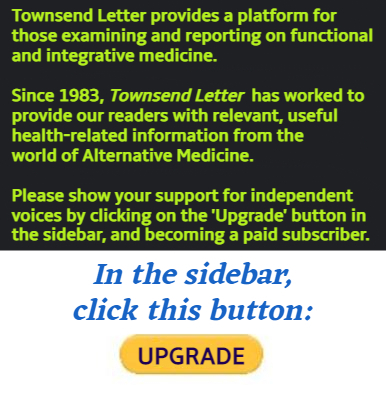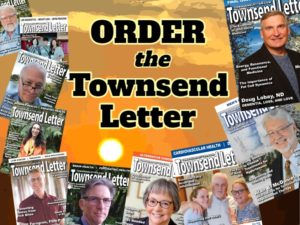by Michael Passwater
Orthomolecular Medicine News Service
One of the lessons learned from the Covid-19 pandemic is that viral infections increase the risk of life-threatening cardiovascular disease. A prospective study in the United Kingdom involving 17,871 patients with Covid-19 and 35,742 controls showed an increased risk of cardiovascular disease following illness from viral infection. The 14,304 mild cases that did not require hospitalization were 2.7 times more likely than controls to have a venous thromboembolism (VTE), and 10.2 times more likely to die during the follow-up period, which averaged 141 days. The 2,701 cases with Covid-19 as the primary reason for hospitalization were 27.6 times more likely than controls to suffer a VTE, 21.6 times more likely to develop heart failure, 17.5 times more likely to suffer a stroke, and 14.6 times more likely to die. 866 cases hospitalized with Covid-19 as a secondary diagnosis also experienced increased cardiovascular events. The increased risks in all groups were greatest during the first 30 days following infection.1 These numbers are striking, but also consistent with data from sepsis patients showing increased risks of cardiovascular disease and death during the “recovery phase” following sepsis.2,3
Nutrient Deficiencies and Disease
Nutrient deficiencies increase the body’s susceptibility to infectious diseases. Furthermore, invading viruses and bacteria and the body’s response to them increase the consumption of vital nutrients.4-6 Vitamins C, D, E, K2, magnesium, glutathione, and selenoproteins (proteins in which selenium has been substituted for sulfur in a cysteine amino acid) are needed to support rapidly dividing and increasingly active immune cells.7-11 Covid-19 has been shown to break down selenoproteins and disrupt antioxidant recycling processes and other vital cellular metabolism pathways. The exacerbation of nutrient deficiencies, including essential amino acids such as lysine, and pathogen-induced metabolic dysfunction increases inflammation, susceptibility to coagulation (blood clotting or bleeding) problems, calcium metabolism and storage problems, and cardiac rhythm problems.12-16

Restoring health is more than eliminating pathogenic microbes. Nutrient levels and biochemical pathways must also be restored. Vitamin C, vitamin K2, vitamin E, and selenoproteins have important roles in maintaining healthy endothelial structure and function (blood vessel walls), and anticoagulation-coagulation balance.8,14,17 Vitamin K2 and vitamin D also have major roles in calcium regulation.18
The amino acid lysine, along with vitamin C, is also established as an important part of the orthomolecular medicine protocol for cardiovascular disease.19,20 Lysine also has complex roles in coagulation. Tranexamic acid (TXA) is an antifibrinolytic medication often used in critical care medicine due to its association with increased survival and decreased bleeding in obstetrics, trauma, and major surgery. TXA is an analogue of lysine (a patentable version of an essential natural molecule).21
Lysine and vitamin C are also important for the production of collagen, which provides structure to arteries. And at high concentrations, free lysine in the blood can saturate the lysine binding sites of lipoprotein(a) preventing the Lp(a) molecules from sticking to blood vessel walls.
Rutin, specifically quercetin-3-rutinoside, is another natural substance of importance for the prevention of thrombosis (blood clots). A decade ago, a Harvard report drew attention to rutin as a leading member of a new class of anticoagulants. It is one of the few substances known (synthetic or natural) that can both help prevent clots and help break down unwanted clots. Rutin also has antioxidant and anti-inflammatory properties, and it has been shown to lower LDL cholesterol and ease arthritis pain.22-24 Rutin, along with catechins, are bioflavonoid phytochemicals found in apples. The rutin content of apples can vary from 12 to 484 mcg/g of apple.25 A therapeutic dose of 250-500 mg of rutin would take 5-10 apples, but it is also available as a dietary supplement. Rutin is also found in figs, asparagus, buckwheat, and black or green tea.
Protocol
Following a serious viral illness, an increased risk of heart attack, heart failure, stroke, venous thromboembolism, and death may persist for months. These risks are especially prominent following Covid-19 infections and may exist even when the acute phase of the illness is mild. During and after illness, it is important to restore the spectrum of nutrient levels to assist with the complete elimination of the infectious agent and to replenish biochemical pathways for optimal wellness. Additional cardiovascular support that includes vitamin C, lysine, and rutin may be indicated throughout recovery.
Recommended Adult Doses to Reduce Risk of Serious Infection:
- Vitamin C, 500-1000 mg, 3 times daily (more to bowel tolerance if sick)
- Vitamin D, 5,000 IU (125 mcg)/day to achieve and maintain vitamin D blood levels in the 40-80 ng/mL range
- Vitamin E, 400-800 IU/day (start with low dose, increase over weeks)
- Vitamin K2, 100 mcg/day
- Niacin/niacinamide 200 – 2,000 mg/d (in divided doses, start with smaller doses, increase over weeks)
- Magnesium 400 mg/d (in malate, citrate, chelate, or chloride form)
- Zinc, 20 mg/day
- Selenium 200 mcg/day as selenium yeast or Se-methyl-L-selenocysteine
Covid Infection Recovery (in addition to the above):
- First month: Rutin, 250 mg twice per day; Lysine 3,000 mg twice per day
- Months 2-4: Consider reducing Rutin to 250 mg per day, and Lysine to 1,000 mg twice per day in the absence of pre-existing cardiovascular disease.
In his book How to Live Longer and Feel Better, Linus Pauling developed a similar protocol for a healthy life.26 His basic approach was to provide the body with the essential vitamins—first and foremost vitamin C—and other micronutrients in the therapeutic amounts it needs to heal. He recommended vitamin C in a dosage of 6-18 g (6,000-18,000 mg in divided doses) per day or until the bowel tolerance limit is reached, and lysine in a dosage of 5-6 g (5,000-6,000 mg in divided doses) per day. The high doses of vitamin C and lysine he recommended, along with adequate doses of other essential nutrients, allow the body’s biochemistry to function at a high level, purge viral infections, and prevent and reverse cardiovascular disease.
References
1. Raisi-Estabragh Z, Cooper J, Salih A, et al. (2022) Cardiovascular disease and mortality sequelae of COVID-19 in the UK Biobank. Heart heartjnl-2022-321492. https://pubmed.ncbi.nlm.nih.gov/36280346
2. Lai CC, Lee MTG, Lee WC, et al. (2018) Susceptible period for cardiovascular complications in patients recovering from sepsis. 190:E1062-1069. https://pubmed.ncbi.nlm.nih.gov/30201613
3. Wang HE, Moore JX, Donnelly JP, et al. (2017) Risk of acute coronary heart disease after sepsis hospitalization in the REasons for Geographic and Racial Differences in Stroke (REGARDS) cohort. Clin Infect Dis. 65:29-36. https://pubmed.ncbi.nlm.nih.gov/28369197
4. Penberthy WT (2022) Niacin for COVID: How niacin, niacinamide, and NAD can help with Long COVID-19. Orthomolecular Medicine News Service. http://www.orthomolecular.org/resources/omns/v18n25.shtml
5. Passwater M (2022) Fueling the Immune System for the 21st Century. Orthomolecular Medicine News Service. http://www.orthomolecular.org/resources/omns/v18n23.shtml
6. Polonikov A. (2020) Endogenous Deficiency of Glutathione as the Most Likely Cause of Serious Manifestations and Death in COVID-19 Patients. ACS Infect Dis. 6:1558-1562. https://pubmed.ncbi.nlm.nih.gov/32463221
7. Carr AC, Maggini S (2017) “Vitamin C and Immune Function”. Nutrients 9:1211; https://pubmed.ncbi.nlm.nih.gov/29099763
8. Passwater, M (2021) Vitamin C Levels in Critically Ill Covid-19 Patients. Orthomolecular Medicine News Service. http://www.orthomolecular.org/resources/omns/v17n17.shtml
9. Horowitz RI, Freeman PR, Bruzzese J (2020) Efficacy of glutathione therapy in relieving dyspnea associated with COVID-19 pneumonia: A report of 2 cases. Respiratory Medicine Case Reports 30:101063. https://pubmed.ncbi.nlm.nih.gov/32322478
10. Ganga HV, Noyes A, White CM, Kluger J (2013) Magnesium adjunctive therapy in atrial arrhythmias. Pacing Clin Electrophysiol. 36:1308-1318. https://pubmed.ncbi.nlm.nih.gov/23731344
11. Wong A-P, Mohamed A-L, Niedzwiecki A (2015) The effect of multiple micronutrient supplementation on quality of life in patients with symptomatic heart failure secondary to ischemic heart disease: a prospective case series clinical study. Am J Cardiovasc Dis. 5:146-152. https://www.ncbi.nlm.nih.gov/pmc/articles/PMC4572086
12. Vavougios GD, Ntoskas KT, Doskas TK. (2020) Impairment in selenocysteine synthesis as a candidate mechanism of inducible coagulopathy in COVID-19 patients. Med Hypotheses 147:110475. https://pubmed.ncbi.nlm.nih.gov/33421689
13. Moghaddam A, Heller RA, Sun Q, et al. (2020) Selenium Deficiency Is Associated with Mortality Risk from COVID-19. Nutrients, 12:2098. https://pubmed.ncbi.nlm.nih.gov/32708526
14. Berenjian A, Sarabadani Z (2020) How menaquinone-7 deficiency influences mortality and morbidity among COVID-19 patients. Biocatalysis and Agricultural Biotechnology. 29:101792. https://pubmed.ncbi.nlm.nih.gov/32952745
15. DiNicolantonio JJ, O’Keefe JH. (2021) Magnesium and Vitamin D Deficiency as a Potential Cause of Immune Dysfunction, Cytokine Storm and Disseminated Intravascular Coagulation in covid-19 patients. Mo Med. 118:68-73. https://pubmed.ncbi.nlm.nih.gov/33551489
16. de Baail JHF, Hoenderon JGJ, Bindels RJM (2015) Magnesium in Man: Implications for Health and Disease. Physiological Reviews 95:1-46. https://pubmed.ncbi.nlm.nih.gov/25540137
17. Glynn RJ, Ridket PM, Goldhaber SZ, et al., (2007) Effects of Random Allocation to Vitamin E Supplementation on the Occurrence of Venous Thromboembolism: Report From the Women’s Health Study. 116:1497-1503. https://pubmed.ncbi.nlm.nih.gov/17846285
18. Shioi A, Morioka T, Shoji T, Emoto M (2020) The Inhibitory Roles of Vitamin K in Progression of Vascular Calcification. Nutrients 12:583. https://pubmed.ncbi.nlm.nih.gov/32102248
19. Cheng RZ (2022) Reversal of Cardiovascular Diseases with Orthomolecular Medicine: Two Case Reports and Literature Review. Orthomolecular Medicine News Service. http://www.orthomolecular.org/resources/omns/v18n12.shtml
20. Diel HW (2022) Lipoprotein(a): The biggest risk factor for heart attack and stroke? My self-experiment with the Pauling therapy and vitamin C. Orthomolecular Medicine News Service. http://www.orthomolecular.org/resources/omns/v18n27.shtml
21. Franchini M, Mannucci PM (2020) The never ending success story of tranexamic acid in acquired bleeding. 105:1201-1205. https://pubmed.ncbi.nlm.nih.gov/32336684
22. Jasuja R, Passam FH, Kennedy DR, et al. (2012) Protein disulfide isomerase inhibitors constitute a new class of antithrombotic agents. J Clin Invest. 122:2104-2113. https://pubmed.ncbi.nlm.nih.gov/22565308
23. Gudrais E (2012) Curbing Clots. Harvard Magazine, September-October 2012 https://www.harvardmagazine.com/2012/09/curbing-clots
24. Gotter A, Wilson DR (2017) The Potential Health Benefits of Rutin. Healthline. https://www.healthline.com/health/potential-benefits-of-rutin
25. Shafi W, Mansoor S, Jan S, et al. (2019) Variability in Catechin and Rutin Contents and Their Antioxidant Potential in Diverse Apple Genotypes. Molecules 24:943. https://pubmed.ncbi.nlm.nih.gov/30866542
26. Pauling L. (1986) How to Live Longer and Feel Better. (2006 Revised Ed) OSU Press. ISBN-13: 978-0870710964.
About the Author
Michael E. Passwater, son of author and columnist Dr. Richard Passwater, is certified by the American Society for Clinical Pathology as a medical technologist, a specialist in immunohematology, and is a diplomate in laboratory management. He has worked in clinical laboratories for 28 years and has previously written “Do the Math: ‘MATH+’ Saves Lives,” published by the Orthomolecular Medicine News Service http://orthomolecular.org/resources/omns/v16n55.shtml .
The Orthomolecular Medicine News Service free subscription link is http://orthomolecular.org/subscribe.html and the OMNS archive link is http://orthomolecular.org/resources/omns/index.shtml.





